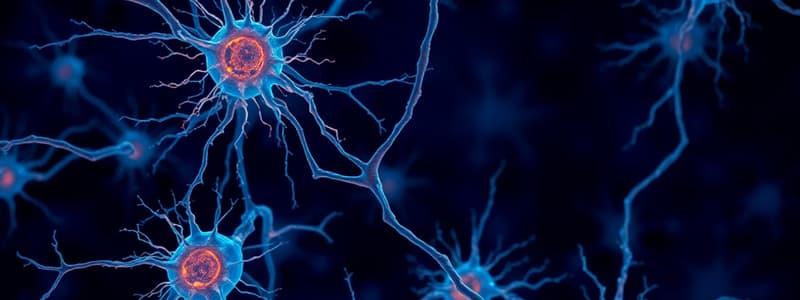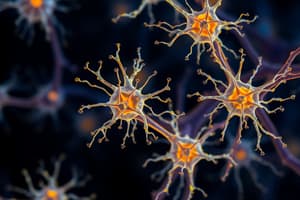Podcast
Questions and Answers
What is the primary function of myelin sheaths?
What is the primary function of myelin sheaths?
- To protect the brain from trauma
- To guide neuronal migration during development
- To insulate axons and speed up electrical signal transmission (correct)
- To supply nutrients to neurons
Which type of cell produces myelin sheaths in the central nervous system?
Which type of cell produces myelin sheaths in the central nervous system?
- Ependymal cells
- Astrocytes
- Microglia
- Oligodendrocytes (correct)
What role do ependymal cells play in the central nervous system?
What role do ependymal cells play in the central nervous system?
- Guiding neuronal migration
- Producing and circulating cerebrospinal fluid (correct)
- Insulating axons
- Supporting metabolic functions of neurons
What is a unique feature of radial glia cells during brain development?
What is a unique feature of radial glia cells during brain development?
Which statement accurately describes satellite glial cells?
Which statement accurately describes satellite glial cells?
How do ependymal cells assist with cerebrospinal fluid (CSF)?
How do ependymal cells assist with cerebrospinal fluid (CSF)?
Which of the following best describes the function of radial glial cells in relation to progenitor cells?
Which of the following best describes the function of radial glial cells in relation to progenitor cells?
What characteristic allows one oligodendrocyte to myelinate multiple axons?
What characteristic allows one oligodendrocyte to myelinate multiple axons?
What role do glial cells play in the central nervous system?
What role do glial cells play in the central nervous system?
Which function is NOT performed by glial cells?
Which function is NOT performed by glial cells?
How do glial cells respond to changes in nerve activity?
How do glial cells respond to changes in nerve activity?
Astrocytes are known for which of the following functions?
Astrocytes are known for which of the following functions?
Which statement about the ratio of glial cells to neurons is correct?
Which statement about the ratio of glial cells to neurons is correct?
What is a common origin of most brain tumors?
What is a common origin of most brain tumors?
What critical role do glial cells play regarding toxins in the nervous system?
What critical role do glial cells play regarding toxins in the nervous system?
Which type of glial cell is primarily responsible for myelination?
Which type of glial cell is primarily responsible for myelination?
What happens to potassium (K⁺) channels during the restoration of the resting potential in a neuron?
What happens to potassium (K⁺) channels during the restoration of the resting potential in a neuron?
What defines the all-or-none principle in action potentials?
What defines the all-or-none principle in action potentials?
What is the role of sodium (Na⁺) ions after an action potential has occurred?
What is the role of sodium (Na⁺) ions after an action potential has occurred?
How does the myelin sheath affect the transmission of nerve impulses?
How does the myelin sheath affect the transmission of nerve impulses?
What occurs during the refractory period after an action potential?
What occurs during the refractory period after an action potential?
What is one of the primary functions of astrocytes in the central nervous system?
What is one of the primary functions of astrocytes in the central nervous system?
Which of the following functions is NOT associated with microglia?
Which of the following functions is NOT associated with microglia?
How do astrocytes contribute to calcium signaling in the brain?
How do astrocytes contribute to calcium signaling in the brain?
What role do oligodendrocytes play in the central nervous system?
What role do oligodendrocytes play in the central nervous system?
Which aspect of astrocyte function is directly related to synaptic modulation?
Which aspect of astrocyte function is directly related to synaptic modulation?
What triggers microglia to become activated?
What triggers microglia to become activated?
What is a significant role of astrocytes in maintaining the blood-brain barrier?
What is a significant role of astrocytes in maintaining the blood-brain barrier?
Which of the following best describes a protective function of microglia?
Which of the following best describes a protective function of microglia?
What is the primary role of Schwann cells in the peripheral nervous system?
What is the primary role of Schwann cells in the peripheral nervous system?
What happens during depolarization of a neuron?
What happens during depolarization of a neuron?
What is the resting potential of a neuron primarily maintained by?
What is the resting potential of a neuron primarily maintained by?
Which process allows for the restoration of a neuron's resting potential?
Which process allows for the restoration of a neuron's resting potential?
How do Schwann cells contribute to nerve injury repair in the PNS?
How do Schwann cells contribute to nerve injury repair in the PNS?
What initiates the action potential in a neuron?
What initiates the action potential in a neuron?
What is the typical duration of an action potential?
What is the typical duration of an action potential?
Which ions are primarily involved in establishing a neuron's resting potential?
Which ions are primarily involved in establishing a neuron's resting potential?
Flashcards are hidden until you start studying
Study Notes
Glial Cells Overview
- Glial cells, derived from the Greek word "glia" (meaning "glue"), support neurons in the central nervous system (CNS).
- Essential for neuron health, glial cells outnumber neurons approximately 10:1.
- While mainly found in the brain and spinal cord, some glial cells are located in the peripheral nervous system (PNS).
Functions of Glial Cells
- Provide physical support to neurons by surrounding and holding them in place.
- Manufacture vital nutrients and chemicals needed for neuron function.
- Absorb toxins and waste materials harmful to neurons.
- Guide the development and migration of neurons during brain formation.
- Myelinate axons via oligodendrocytes, enhancing electrical signal transmission.
- Respond to nerve activity, aiding in regulating synaptic functions and communication between neurons.
- Influence learning and memory by modulating neuronal communication.
- Most brain tumors, such as gliomas, originate from mutations in glial cells.
Types of Glial Cells
-
Astrocytes:
- Star-shaped cells supporting neurons and maintaining homeostasis.
- Deliver nutrients to neurons and regulate ions in extracellular fluid.
- Form part of the blood-brain barrier, protecting the brain from harmful substances.
- Active in response to nerve activity, modulating communication.
-
Microglia:
- Function as immune cells in the CNS, acting as scavengers for dead or damaged cells.
- Involved in phagocytosis to digest harmful substances.
- Activated during neuroinflammation, contributing to diseases like Alzheimer's.
-
Oligodendrocytes:
- Responsible for forming myelin sheaths around CNS axons for efficient signal transmission.
- Can myelinate multiple axons simultaneously.
-
Ependymal Cells:
- Line ventricles in the brain and the spinal cord's central canal.
- Produce and circulate cerebrospinal fluid (CSF), cushioning the brain.
-
Radial Glia:
- Act as scaffolding during brain development, guiding new neurons to final positions.
- Can differentiate into various cell types, including neurons and astrocytes.
-
Satellite Cells:
- Found in PNS ganglia, providing structural and nutrient support to neurons.
- Regulate the chemical environment around neurons.
-
Schwann Cells:
- Generate myelin in the PNS, insulating axons to enhance conduction speed.
- Facilitate nerve repair and regeneration after injury.
Electrical Activity of Neurons
- Neurons generate electrical impulses and release neurotransmitters for communication.
- Resting potential is established by an uneven ion distribution, primarily maintaining sodium (Na⁺) outside and potassium (K⁺) inside.
Nerve Activation Steps
- Resting Potential: Neuron at rest exhibits a negative charge (~-70 mV).
- Action Potential: Stimulation opens ion channels, resulting in a positive charge (+40 mV) and triggering an impulse.
- Restoration: The neuron returns to resting state through sodium and potassium balance restoration.
Myelin Sheath
- A fatty layer formed by glial cells that insulates axons and accelerates nerve impulse transmission.
- Damage to the myelin sheath can lead to conditions like multiple sclerosis, disrupting communication between the brain and muscles.
Studying That Suits You
Use AI to generate personalized quizzes and flashcards to suit your learning preferences.




